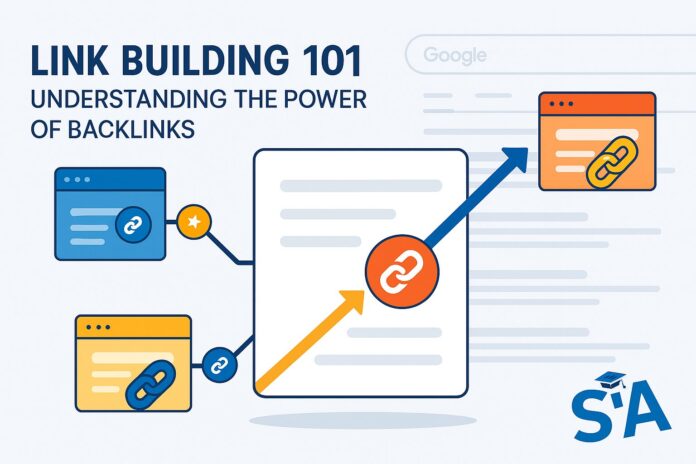Have you ever wondered how some websites seem to magically appear at the top of Google search results? Or why your competitor’s site consistently outranks yours despite offering similar products or services? The secret often lies in the power of backlinks. In this guide, we’ll explore the fundamentals of link building—what industry insiders often call “backlinks 101″—to help you understand how these digital endorsements can transform your online presence.
Think of backlinks as votes of confidence from one website to another. When reputable sites link to your content, search engines view this as a signal that your information is valuable and trustworthy. But not all backlinks are created equal—a few high-quality links from respected industry sites often carry more weight than dozens of random, low-quality ones.
By the time you finish reading this comprehensive guide, you’ll understand not only what backlinks are but also how to acquire them naturally, identify quality link opportunities, and implement strategies that work for businesses of any size, anywhere in the world. Whether you’re a complete beginner or looking to refine your existing approach, this post will equip you with the knowledge to build a stronger, more authoritative online presence.
Introduction to Link Building
What Is Link Building in SEO?

Link building in SEO is the process of acquiring hyperlinks from other websites to your own. These links create pathways for users to navigate between pages on the internet, but they serve a much more significant purpose for search engines. When Google and other search engines crawl websites, they use links to discover new content and determine how pages should rank in search results.
As Moz explains in their Beginner’s Guide to Link Building, these digital votes of confidence help search engines understand which pages deserve to rank for competitive terms. A well-executed link building strategy involves earning links from relevant, authoritative websites that genuinely want to share your content with their audience.
Why Backlinks Matter for Websites Worldwide
Whether you run a local bakery in Sydney, a tech startup in Silicon Valley, or an e-commerce store serving global markets, backlinks play a crucial role in your online visibility. Backlinko’s analysis of 11.8 million Google search results found that the number of domains linking to a page correlated with rankings more than any other factor.
For local businesses, including those in Australia, regional links from trusted local sources can significantly boost visibility in geo-specific searches. Meanwhile, international businesses benefit from diverse link profiles that include authoritative sources from various relevant markets.
The Impact of Backlinks on Search Engine Rankings
Google’s algorithms have evolved significantly over the years, but links remain one of the top three ranking factors, according to Search Engine Journal’s ranking factors study. Quality backlinks signal to search engines that others vouch for your content’s value and reliability.
However, it’s important to note that poor-quality or manipulative links can trigger penalties. According to Google’s Webmaster Guidelines, any links intended to manipulate rankings could violate their guidelines and harm your site’s performance. This is why modern link building focuses on earning links through valuable content and genuine relationships rather than artificial tactics.
Understanding Backlinks
What Is a Backlink on a Website?
A backlink is simply a link from one website to another. If you run a fitness blog and a nutrition website links to your article about post-workout meals, that’s a backlink to your site. These digital references serve as pathways for users to discover your content while simultaneously signaling to search engines that others find your information valuable enough to reference.
Search Engine Journal’s guide to backlinks explains that each backlink essentially functions as a vote of confidence, increasing the likelihood that search engines will display your content to users searching for relevant information.
Different Types of Backlinks and Their Importance
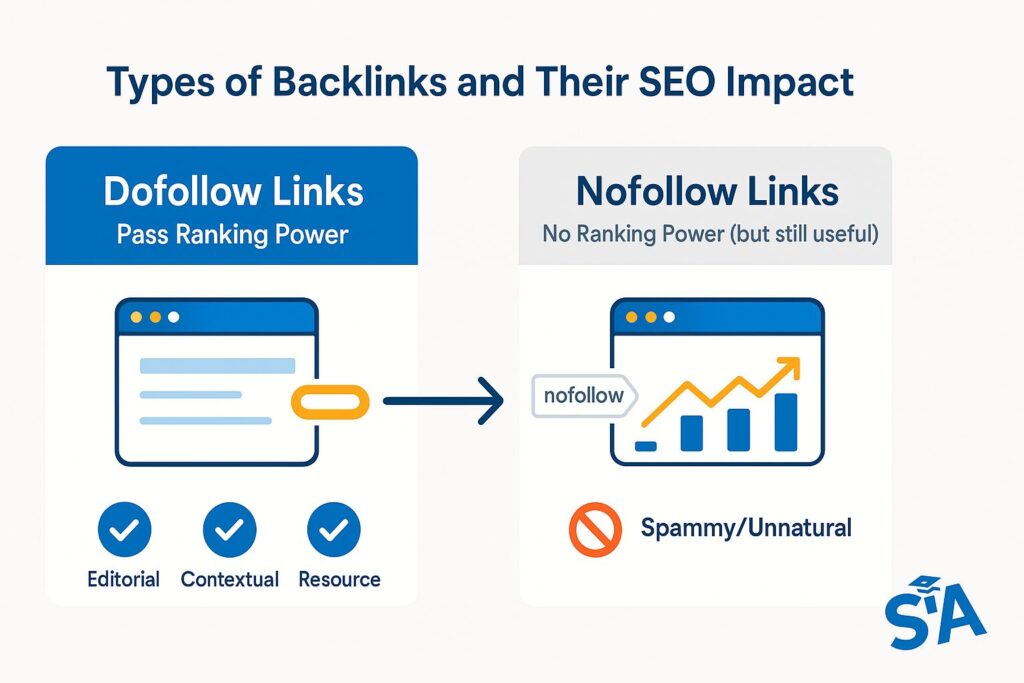
Not all backlinks carry the same weight in the eyes of search engines. The two primary types are:
- Dofollow links: These pass “link equity” (ranking power) from one site to another, directly influencing search rankings. As Ahrefs’ study on dofollow links demonstrates, these are the links that most SEO professionals focus their efforts on acquiring.
- Nofollow links: These contain a special HTML attribute that tells search engines not to pass ranking credit. While they don’t directly boost rankings, Search Engine Land reports that nofollow links still drive referral traffic and may indirectly influence rankings as part of a natural link profile.
Other important variations include:
- Editorial links: Naturally placed within content because the author genuinely wants to reference your site
- Contextual links: Placed within the body of relevant content
- Resource links: Included in resource lists or recommended reading sections
Identifying High-Quality vs. Low-Quality Backlinks
The quality of your backlinks matters far more than the quantity. High-quality backlinks typically come from websites that are:
- Relevant to your niche or industry
- Authoritative and trusted in their field
- Generating real traffic themselves
- Selective about which external sites they link to
According to Neil Patel’s guide on evaluating backlinks, you should consider metrics like domain authority, relevance, and traffic when assessing link quality. Tools like Ahrefs, Moz, and SEMrush can help you analyze these factors.
Low-quality links often come from spammy directories, link farms, or completely irrelevant websites. Google’s Link Schemes documentation warns that these types of links can actually harm your site’s ranking rather than help it.
How to Create Backlinks to Your Site for Free
Free Link Building Websites and Directories
Business directories remain one of the simplest ways to build foundational backlinks. While local directories like True Local are valuable for Australian businesses, international options like Yelp, Better Business Bureau, and industry-specific directories can benefit businesses worldwide.
BrightLocal’s Local Citations Study found that business listings not only provide backlinks but also increase consumer trust. When selecting directories, prioritize those that are relevant to your industry and location, have strict submission guidelines (a sign of quality control), and display links without the nofollow attribute when possible.
Guest Posting and Content Collaboration

Guest posting involves creating content for other websites in exchange for a link back to your site. This strategy remains effective when done with genuine value in mind. According to Orbit Media’s blogging survey, 60% of bloggers who write guest posts report “strong results.”
To implement this strategy:
- Identify relevant blogs in your industry that accept guest contributions
- Study their content to understand their audience and style
- Pitch unique, valuable content ideas (not promotional material)
- Include natural links to your most relevant content
Content collaborations can take many forms beyond guest posting, including expert roundups, interviews, case studies, or joint research projects. These partnerships often result in mutual link exchanges that benefit both parties.
Maximizing Social Media for Free Backlinks
While most social media links are nofollow and don’t directly pass ranking power, they play an important role in content distribution and link building. Hootsuite’s social media impact study shows that active social profiles can indirectly improve SEO by:
- Increasing content visibility, leading to more natural backlinks
- Building relationships with potential linkers and content partners
- Creating brand recognition that boosts click-through rates in search results
Each platform offers unique opportunities: LinkedIn is excellent for B2B content promotion, while Pinterest can drive significant traffic for visual content. Twitter facilitates quick connections with journalists and content creators who might link to your resources.
Key Link Building Strategies
4.1 Traditional Methods: Outreach, Partnerships, and Local Citations
Email outreach remains one of the most effective link building methods when done correctly. Respona’s outreach study found that personalized outreach emails with specific, relevant value propositions achieve response rates up to 5 times higher than generic messages.
Successful outreach typically follows this process:
- Identify relevant websites that might benefit from your content
- Find the appropriate contact person (not just a generic email)
- Craft a personalized message explaining the specific value of your resource
- Follow up thoughtfully without being pushy
Local citations (mentions of your business name, address, and phone number) are particularly valuable for businesses with physical locations. BrightLocal’s Local SEO Industry Survey indicates that citation building remains among the top five most effective local SEO tactics.
Modern Approaches: Podcast Guesting, Expert Roundups
As content formats evolve, so do link building opportunities. Podcast guesting has emerged as a particularly effective strategy, with Podcast Insights reporting that there are over 2 million active podcasts with engaged audiences looking for expert insights.
When you appear as a guest on a relevant podcast, you typically receive:
- A backlink in the show notes
- Exposure to a targeted audience
- The opportunity to demonstrate expertise
- Connections with the host and their network
Expert roundups gather insights from multiple authorities on a specific topic. By contributing thoughtful answers to roundup requests from sites like HARO (Help A Reporter Out), you can earn high-quality editorial links from news sites and industry publications.
Broken Link Building Tactics
Broken link building involves finding dead links on other websites and suggesting your content as a replacement. According to Ahrefs’ broken link building guide, this approach works because it helps website owners fix problems while providing you with link opportunities.
The process typically involves:
- Finding resource pages in your niche using search operators like “keyword + resources” or “keyword + links”
- Checking these pages for broken links using browser extensions like Check My Links
- Creating or identifying content on your site that could replace the broken resource
- Contacting the webmaster with a helpful notification about the broken link and suggesting your content as a replacement
This strategy works particularly well for resource-heavy industries like education, healthcare, and technology.
How to Find Link Building Opportunities
Conducting a Competitor Analysis
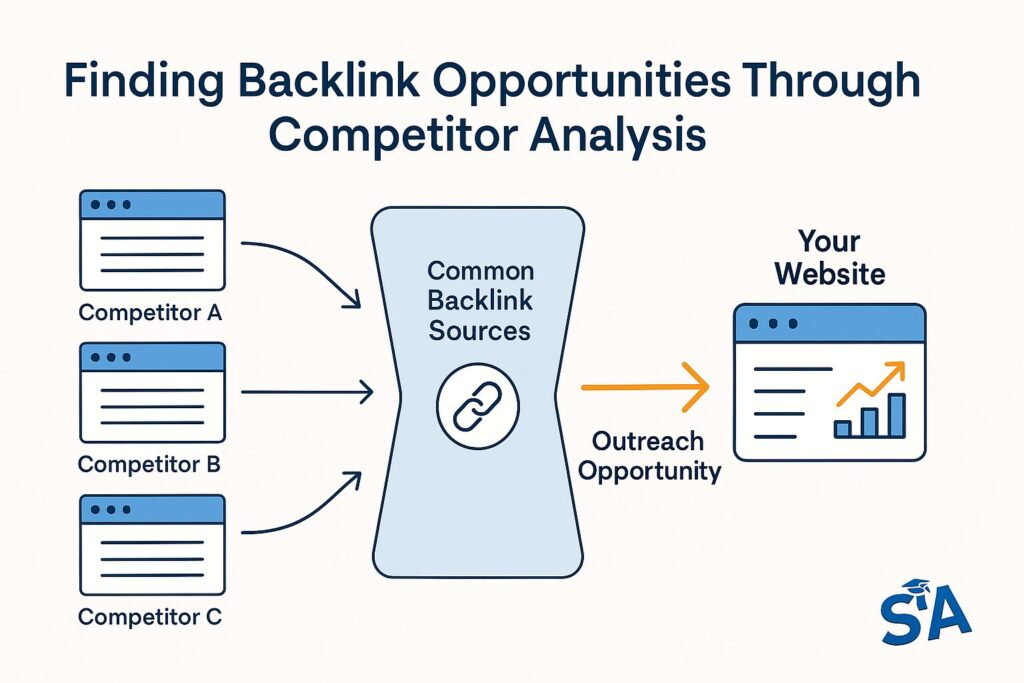
One of the most efficient ways to find link opportunities is to analyze where your competitors are getting their links. SpyFu’s competitive analysis guide demonstrates that studying competitor backlinks can reveal:
- Which sites are likely to link to content in your industry
- What types of content attract the most links in your niche
- Gaps where you could create superior resources to earn similar links
Start by identifying your top-performing competitors, then use tools like Ahrefs, SEMrush, or Moz to examine their backlink profiles. Look for patterns in the types of sites linking to them and the content formats that earn the most links.
Using SEO Tools to Find Backlinks to a Site
Specialized SEO tools make it much easier to discover and analyze backlink opportunities. Backlinko’s SEO tools guide highlights several excellent options:
- Ahrefs offers comprehensive backlink analysis with metrics like Domain Rating and URL Rating to assess link quality
- SEMrush provides backlink gap analysis to find sites linking to competitors but not to you
- Moz Link Explorer shows Domain Authority and spam scores to help evaluate link quality
- Google Search Console offers free insights into which sites are already linking to you
These tools not only show where links are coming from but also help you understand the context, anchor text, and relative value of each link.
Networking and Industry Associations
Sometimes the best link building opportunities come from real-world connections. Industry associations, chambers of commerce, professional organizations, and trade groups typically maintain member directories that include valuable backlinks.
Content Marketing Institute’s research shows that in-person networking at industry events often leads to content collaborations and link opportunities that wouldn’t emerge through cold outreach alone.
For local businesses, involvement in community events, sponsorships, and charitable initiatives can lead to press coverage and links from local news sites, which typically have high domain authority.
Step-by-Step Guide: How to Build Links to Your Website
How to Build Links for Your Website
Building effective links requires a systematic approach that starts with your own content. As Orbit Media’s content marketing study shows, websites that publish high-quality, original research receive 4x more backlinks than those publishing standard blog posts.
Follow these steps to build a strong foundation for link acquisition:
- Create linkable assets — Develop content that naturally attracts links, such as original research, comprehensive guides, or unique tools that solve problems for your audience
- Research target sites — Identify websites that link to similar content or serve your target audience
- Personalize your outreach — Craft individualized pitches that explain specifically how your content benefits their audience
- Follow up strategically — Send thoughtful follow-ups that add value rather than just checking in
- Track results — Monitor which approaches yield the best results and refine your strategy accordingly
Content Relevance vs. Link Quantity
Many website owners wonder whether they should focus on acquiring many links or fewer, more relevant ones. Search Engine Journal’s quality vs. quantity study found that relevance consistently outperforms pure volume in terms of ranking impact.
Google’s algorithms have become increasingly sophisticated at evaluating contextual relevance between linking sites. A link from a closely related industry site with moderate authority typically provides more ranking benefit than a link from a high-authority site with no topical connection to your content.
This doesn’t mean you should ignore high-authority opportunities, but rather that you should prioritize relevance when evaluating potential link sources.
Internal Linking and Site Structure
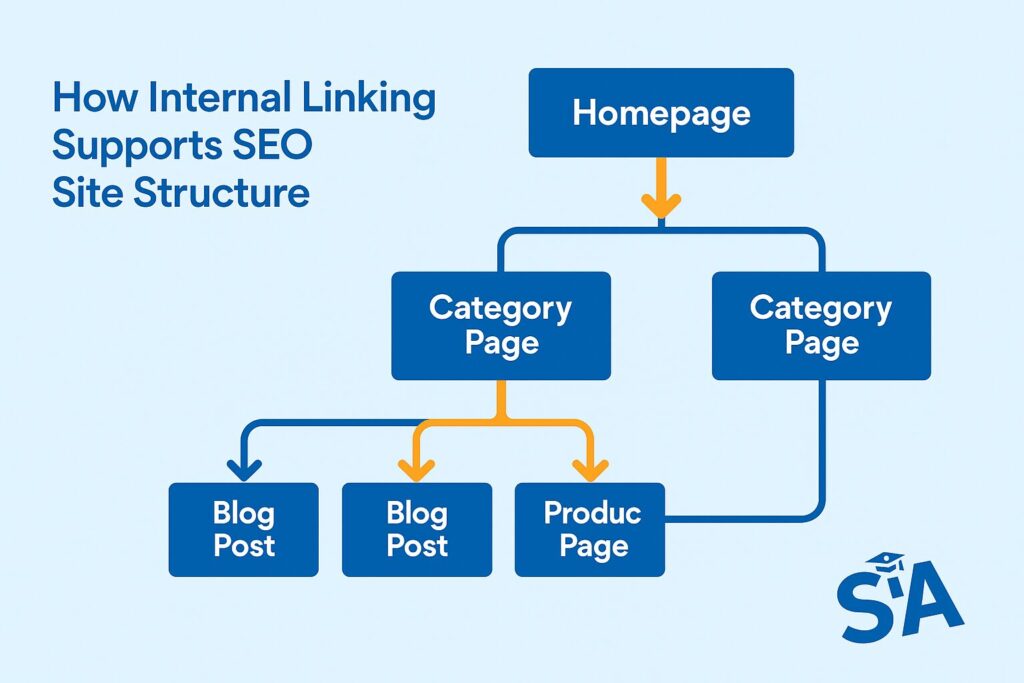
While external links get most of the attention, internal links (links between pages on your own site) play a crucial role in distributing link equity and helping search engines understand your content hierarchy.
According to Search Engine Journal’s internal linking study, strategic internal linking can significantly improve rankings for target pages by:
- Helping search engines discover and index content
- Establishing content hierarchy and topic relationships
- Distributing link equity throughout your site
- Keeping visitors engaged with related content
An effective internal linking strategy connects related content, uses descriptive anchor text, prioritizes important pages, and creates a logical site structure that both users and search engines can easily navigate.
Boosting Your Online Presence with Free Link Building Sites
Leveraging Local and Global Directories
Directory listings remain a valuable source of backlinks, particularly for local businesses. While Australian businesses benefit from listings on sites like Yellow Pages Australia, businesses worldwide can leverage both global and regional directories.
According to BrightLocal’s citation impact report, consistent NAP (Name, Address, Phone) information across key directories correlates with higher local search rankings.
Some valuable global directories include:
- Google Business Profile (essential for all businesses)
- Industry-specific directories relevant to your niche
- Chamber of Commerce websites for your region
- Better Business Bureau (in applicable regions)
When submitting to directories, prioritize completeness—profiles with comprehensive information, photos, and business details tend to perform better in search results.
Community Forums and Q&A Platforms
Online communities provide opportunities to demonstrate expertise while building backlinks. According to Semrush’s forum marketing guide, thoughtful participation in industry discussions can lead to both direct and indirect link opportunities.
Platforms like Quora, Reddit, and industry-specific forums allow you to:
- Answer questions in your area of expertise
- Link to relevant resources when genuinely helpful (following community guidelines)
- Build relationships with potential collaborators
- Establish authority that leads to other link opportunities
The key to success is adding genuine value rather than simply promoting your content. Helpful, insightful contributions build reputation, while obvious self-promotion can damage it.
Claiming Your Brand Mentions for Additional Links
One often overlooked opportunity is converting unlinked mentions into backlinks. Mention’s brand monitoring guide explains that many websites may mention your brand or products without linking to your site.
Tools like Google Alerts, Ahrefs Content Explorer, or Brandwatch can help you track brand mentions across the web. When you find an unlinked mention, a simple email to the author or webmaster often results in them adding a link.
This approach is particularly effective because:
- The site has already demonstrated willingness to mention your brand
- Adding a link provides value to their readers
- It requires minimal effort from the website owner
How to Do Link Building for My Website
Creating a Strategic Link Building Plan
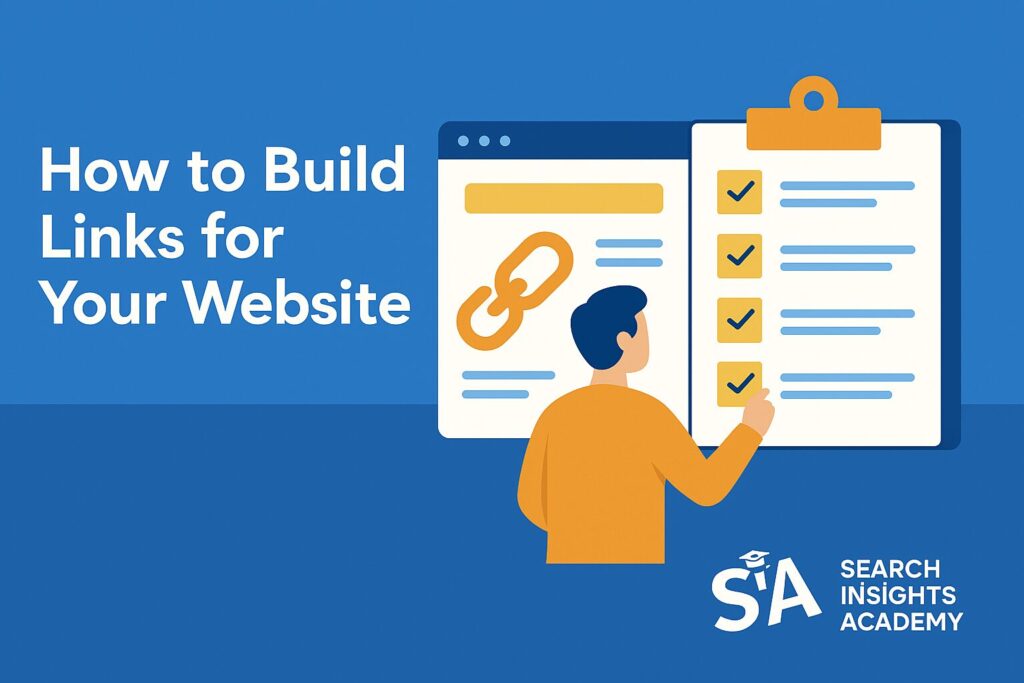
Effective link building requires planning rather than random efforts. Content Marketing Institute’s B2B content marketing report found that documented strategies lead to significantly better results across all marketing metrics, including backlink acquisition.
A comprehensive link building plan should include:
- Clear goals (e.g., specific number of referring domains, improved rankings for target keywords)
- Content assets to create or leverage for link building
- Target websites categorized by priority and likelihood of success
- Outreach templates customized for different types of opportunities
- Timeline with milestones and check-in points
- Tracking system to measure results
This strategic approach helps coordinate efforts across team members and ensures consistent progress.
Scheduling and Consistency
Consistency matters more than intensity when building links. Backlinko’s link building case study demonstrates that steady, ongoing effort produces better results than sporadic campaigns.
A sustainable approach might involve:
- Setting realistic weekly outreach targets
- Allocating specific time blocks for link building activities
- Creating a content calendar aligned with link acquisition goals
- Building relationships over time rather than focusing on immediate results
This measured approach appears more natural to search engines and is easier to maintain alongside other marketing activities.
Measuring Results and Fine-Tuning Your Approach
To improve your link building, you need to measure its effectiveness. Ahrefs’ ROI tracking guide recommends monitoring several metrics:
- Growth in referring domains and backlinks
- Improvements in domain authority or domain rating
- Ranking changes for target keywords
- Organic traffic increases
- Conversion rates from referral traffic
Tools like Google Analytics, Google Search Console, and dedicated SEO platforms provide these insights. By analyzing which types of content and outreach methods generate the best results, you can continuously refine your approach.
Frequently Asked Questions and Quick Tips
How to Get Quality Backlinks for Free
Getting quality backlinks without a budget requires creativity and effort. Search Engine Journal’s free link building guide highlights several effective approaches:
- Create shareable, data-driven content that naturally attracts links
- Offer expert quotes or insights to journalists through HARO
- Develop free tools or resources that solve common problems in your industry
- Participate thoughtfully in online communities where your expertise is relevant
- Build relationships with content creators in complementary niches
These methods leverage your expertise and content rather than your budget to earn valuable backlinks.
How to Increase Site Linking and Generate More Backlinks
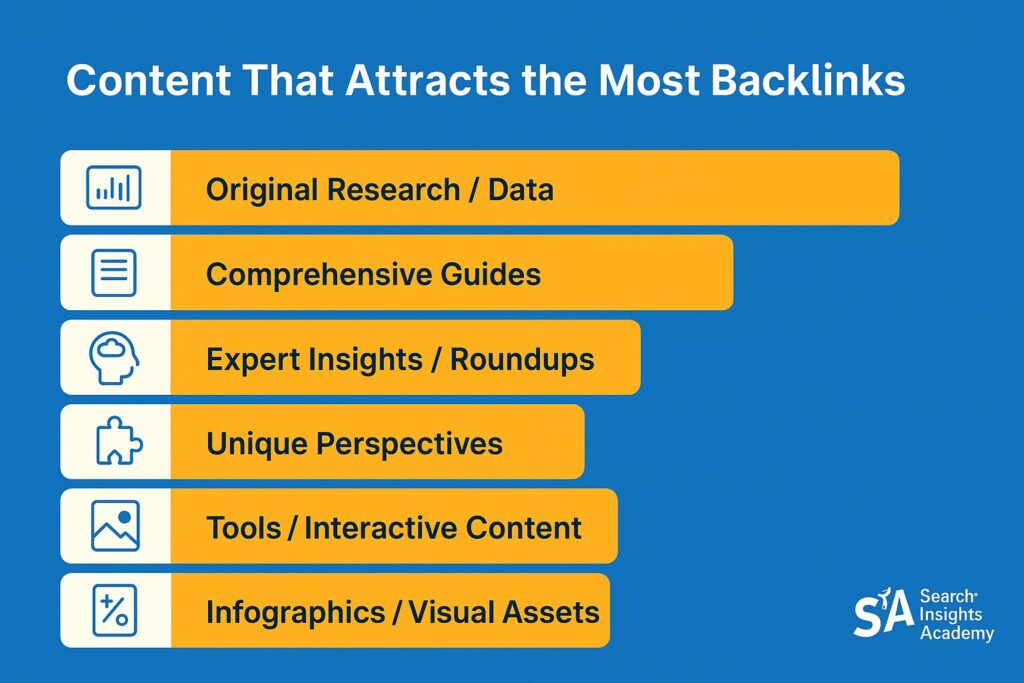
Increasing the number of sites linking to yours starts with creating link-worthy content. According to BuzzSumo’s content study, the content types that earn the most backlinks include:
- Original research and data
- Comprehensive guides and tutorials
- Contrary or unique perspectives on industry trends
- Visual assets like infographics and diagrams
- Tools and interactive resources
Once you’ve created compelling content, active promotion through email outreach, social sharing, and community participation helps ensure it reaches potential linkers.
How to Find Backlink Sources and Track Your Progress
Finding new backlink sources requires ongoing research. SpyFu’s link prospecting guide recommends several methods:
- Analyzing newly acquired competitor links
- Setting up alerts for relevant industry terms
- Monitoring discussions in online communities
- Tracking mentions of competing products or services
- Identifying sites that link to multiple competitors
For tracking progress, tools like Google Search Console provide free insights into your backlink profile, while paid tools like Ahrefs and SEMrush offer more comprehensive analytics and competitive comparison features.
How to Backlink Your Website and Common Mistakes to Avoid
When building backlinks to your website, avoid these common mistakes identified by Search Engine Journal’s link building mistakes article:
- Using exact-match anchor text too frequently (appears manipulative)
- Acquiring links from irrelevant websites or link networks
- Neglecting the value of nofollow links from high-traffic sources
- Focusing on quantity over quality and relevance
- Failing to vary your link acquisition methods
Instead, focus on building relationships, creating genuinely valuable content, and earning links that would make sense even if search engines didn’t exist.
Conclusion and Next Steps
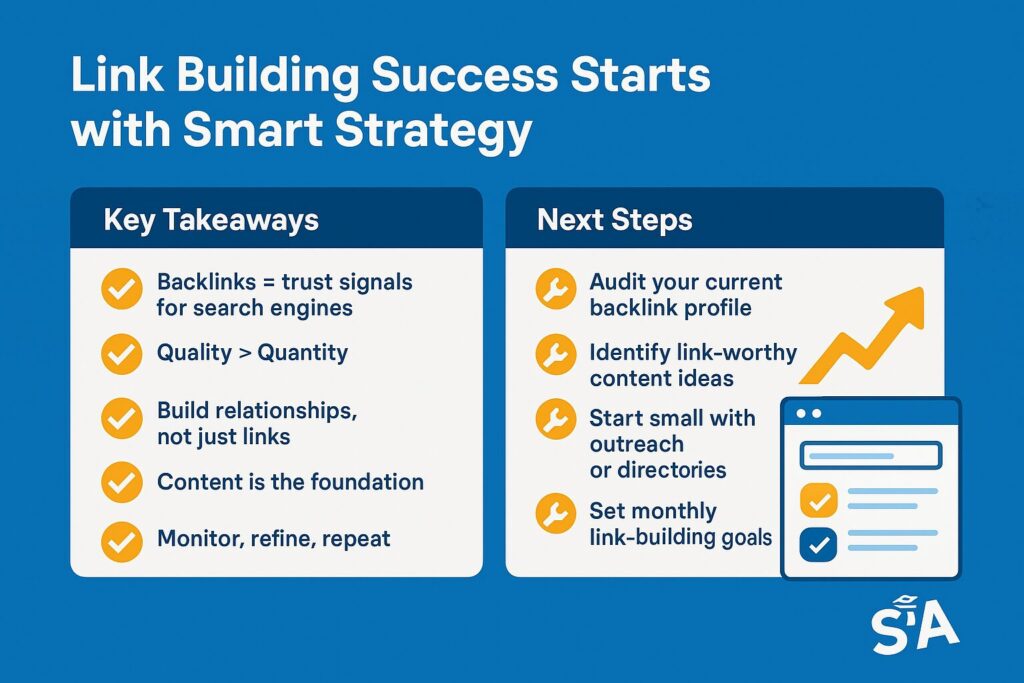
Backlinks remain one of the fundamental building blocks of search engine optimization. Throughout this guide, we’ve explored the core principles of link building—from understanding what makes a quality backlink to implementing diverse strategies for earning them naturally.
Remember that effective link building is a marathon, not a sprint. The most successful websites build their backlink profiles gradually through consistent effort, valuable content creation, and genuine relationship building. While tactics may evolve, the underlying principle remains the same: create something worth linking to, and then make sure the right people know about it.
As you develop your link building strategy, focus on quality, relevance, and sustainability rather than quick wins. Monitor your results, learn from both successes and failures, and continuously refine your approach based on what works for your specific industry and audience.
Whether you’re just starting out or looking to improve an established website, thoughtful link building will reward your efforts with improved visibility, authority, and ultimately, better business results. The journey may be challenging, but the destination—a strong, authoritative online presence—is well worth the investment.Add to Conversation

